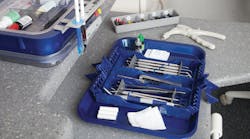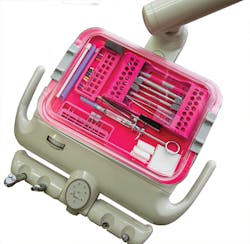It can be easy for oral health-care professionals to overlook the importance of organization when it comes to our dental instruments and materials, but the cost of disorganization can be high. Clutter and chaos can cause serious losses in productivity for dental practices, leading to more significant problems down the line. When treatment rooms and central sterilization areas are disorganized, they account for significant amounts of financial and emotional stress. In addition, schedules start falling behind and inventory management is inefficient, yielding an excess amount of clutter. Staff and patients experience more stress, extra time is spent in room turnover, and communication systems begin to fail. Color-coded containers and storage solutions specifically developed for dental teams can provide relief to all these problems by incorporating a visual element into both instrument and material organization.
What is Color Method?
Color Method is the process of managing dental instruments and materials by assigning each procedure a different color. Zirc’s Color Method creates a streamlined, stress-free, day-to-day routine from setup to sterilization in five simple steps. Implementing a simple system by assigning a color to each procedure in the practice can really impact organization in the workspace. Once colors are assigned, teams use corresponding trays, tubs, locking covers, cassettes, and more to organize their materials and instruments. The storage system’s design means our everyday setups are easily identifiable, accessible, neat, and hygienic. Color is the key to creating a properly organized workflow optimized for efficiency. I have implemented Color Method and can attest to its streamlined and automated processes that have transformed our entire practice into an office that is organized and allows us to better focus on our patients. When instruments and materials move efficiently, so do you. This method saves me steps every day. I no longer have to run out of the room to get an item that I forgot or shuffle around in my op to find barriers or materials.
How to implement Color Method into your practice
Once you have chosen your colors, it’s time to get organized. Start with instrument management, using trays with locking covers, cassettes, and bur holders to help save time in looking for missing items. E-Z Jett Cassettes come in six different sizes and a variety of bur holders, allowing you to choose what best meets your instrument needs. Not only do color-coded containers save time, but they also provide the following benefits:
- Efficiency. Instruments are kept together from sterilization right through to procedure and storage. This ensures that no items are misplaced and the correct tools for each procedure are all in one place. There is less sorting, so you’ll save time and eliminate the chance of reprocessing errors.
- Cost-savings. Durable, antimicrobial, affordable cassettes protect the instruments, prolonging equipment life and saving money on replacing items before their expiration date.
- Infection prevention. Cassettes offer a unique type of protection from disease exposure to staff. Handling contaminated instruments less frequently will minimize the chances of injury. The clear locking tray covers allow practitioners to easily and quickly see their instruments, while remaining compliant with the Occupational Safety and Health Administration (OSHA) and the Centers for Disease Control and Prevention (CDC) in instrument transportation.
- Patient perception. Patients who are exposed to a clean, well-organized workspace will automatically feel more at ease in your office.
Central sterilization
Zirc’s clinical and efficiency team recommends storing tray setups and tubs in central sterilization, creating a “grab-n-go organization.” With a color chart posted in the sterilization area, any team member can easily grab the blue tray and blue tub to have everything they need for the upcoming procedure. Have you ever found yourself scrambling for time to reprocess instruments? The B-Lok Tray with cover provides stackable storage so team members can assist one another with instrument reprocessing. Imagine you are a new hire or temping in a new office. You walk into the sterilization area to find Multi-Mod Racks that store the instrument setups, and tubs housing the specific procedure materials and consumable items. The posted color-code chart quickly identifies the color for hygiene as purple. Everything you need will be found within purple cassettes, purple trays, and purple tubs. The trays are stacked so you can drop your dirty trays and grab the next setup with all the items you’ll need. You don’t have to scramble to find where barriers are, HVE tips, etc. Does this sound like utopia? Or maybe a dream? This was always my frustration when temping. I felt like a cook in someone else’s kitchen, or even worse, I felt like a burden when I had to ask others to help me find items.
Uncluttered treatment rooms
One of the most significant advantages of using color-coded storage options is an uncluttered room. With all procedure-specific materials stored together, dental hygienists can offer an attractive, well-organized space that presents a highly professional image and helps with infection prevention. Not every op is blessed with cabinets and drawers. This means if items are being stored in the op, they might be left out on the countertop, which creates an infection control concern and doesn’t look very professional. Color-coded procedure tubs can also help save money with less needed inventory. Teams will reduce the accidental use of expired materials, eliminate missing materials chairside, enable efficient inventory control, and assist in easy restocking. Let’s imagine you have four hygiene operatories. If you are placing sealant material in each op, and one hygiene room is more active than others, that material could expire without anyone noticing. This meant we had to purchase four of everything to equip those rooms. Now, imagine we have that sealant material in a procedure tub. We only have material for sealants in one place, and it can easily travel from room to room. We have already cut costs by not buying material to stock every single room, and we have reduced the chance that the material would expire before the clinicians get to use it.
Case studies
Southside Dental is a practice in Minnesota that uses the Color Method and has seen positive outcomes resulting from its implementation. This system created an 85% reduction in chairs being left during a procedure while dental staff searched for instruments and a 54% decrease in time spent sorting, wrapping, and loading the autoclave. It also led to a reduction in treatment rooms needing restocking by 76% and saved 67% on the time needed to restock the rooms. The dental team at this practice has also benefited from staying on schedule, being OSHA compliant, spending less time on setups, no longer having to dig through drawers, and much more thanks to this newly implemented method.
Stonehaven Dental, located in Draper, Utah, also implemented the color-coding system, and they couldn’t be happier. Their team reported being more confident and efficient with elevated levels of patient care, thanks to the few simple changes made using this method. With new streamlined training procedures, organized instruments, clutter-free treatment rooms, and restocking and inventory issues now solved, the Stonehaven team is an example of just how effective this system is.
Added advantages
When hiring new team members, color-coded systems can enable their training to go that much faster. Instead of spending hours going through training on equipment and having new hires search for misplaced items, one can simply teach them which procedures match which colors, and they can settle into their jobs much quicker. It’s that simple. When offices streamline and automate their clinical processes, they have more time to focus on what matters most—more time with their patients. It’s important that the entire dental team utilize good clinical systems to support one another and create a cohesive work environment. We have all experienced those days when the dentist and assistant aren’t working efficiently, and it can negatively affect you and your patients, and vice versa.
How color boosts efficiency
By implementing the color-coded method, oral health-care professionals can increase their efficiency, save time, and avoid misplaced materials and instruments. They can also reduce the number of expired materials, improve patient perception, meet OSHA regulations and compliance, simplify training, and reduce stress. Another benefit of using Color Method is esthetic. Dental offices can often seem cold and unwelcoming since the decor must be kept minimal for hygienic reasons. This sterile environment may impact the levels of stress and anxiety in patients. Bringing some color into the treatment rooms instantly brightens things up and makes patients feel less intimidated. When patients are more relaxed and confident, it’s easier for everyone. The brightly colored setups and optimized organization can help inspire a sense of security and well-being for even the most anxious of clients. This system is simple, easy to implement, and has made noticeable differences in the dental practices that have implemented Color Method. With so many benefits and savings to be made, there’s no doubt that a small change can improve the overall office efficiency and confidence of team members. Why not bring some color and organization into your office today?
Editor's note: This article appeared in the October 2021 print edition of RDH.
Michelle Strange, MSDH, RDH, brings over 20 years of experience to her numerous roles in dentistry. A graduate of the Medical University of South Carolina with a bachelor’s of health science and the University of Bridgeport with a master’s in dental hygiene education, she is focused on expanding the knowledge of her colleagues in all aspects of health care. Strange’s passion for dentistry and its connection to overall health extends to her community and global efforts. Currently, she is the cofounder and cohost of the longest-running podcast for dental hygienists, A Tale of Two Hygienists, the cofounder of Level Up Infection Prevention and TriviaDent, a practicing dental hygienist, and client success manager for MouthWatch.








